60 Nonfiction Books for Kindergarten and 1st Grade, 5- and 6-Year- Olds
This post may contain affiliate links.
Kindergartners who are 5- and 6-year-old beginning readers need to read nonfiction books as well as fiction books. They’ll practice different comprehension skills & learn how to read for information. Here are some excellent book choices for your readers.
Remember, it’s okay if your children aren’t reading independently. You can read any of these nonfiction books out loud to them.
This list includes nonfiction books, but I’m also including some informational fiction books, too. I like informational fiction (where the characters talk) because they’re like gateway books to pure nonfiction options.
ALSO READ:
NONFICTION BOOKS FOR ALL AGES
Nonfiction Reading Comprehension Strategies
Nonfiction Books for Kindergarten and 1st Grade, 5- and 6- Year Olds

Joey: A Baby Koala and His Mother by Nic Bishop
I adore that this book is PERFECT for new readers — with simple text that tells a little story about a hungry baby Koala. Gorgeous photographs and design! “He tries to wake her. He scratches her ear. He climbs on her head. But Mom is not ready to wake up.“

Balance the Birds by Susie Ghahremani
This book simplifies the math concept of weights and balances as birds land and leaves the tree branches in captivating, whimsical illustrations.

Fox Explores the Night written by Martin Jenkins, illustrated by Richard Smythe
A nocturnal fox searches for food in a busy city. She finds supper in someone’s backyard then returns home. It’s a purposefully simple book with guided questions in the back such as “Can you find examples of different light sources in the book?“

Cicada Symphony written by Sue Fliess, illustrated by Gareth Lucas
From their beginnings as nymphs below ground, this exciting adventure shows the cicada life cycle and I love it! Large text shares a narrative story: “To the surface, up they go. No one tells them. They just know. Gripping tight for one last change. Split. Pop! Wriggle. Looking strange.” Smaller text with informational facts peppers the pages, too. “Cicadas can be as noisy as a lawnmower, motorcycle, or chainsaw.”

As Night Falls Creatures That Go Wild After Dark written by Donna Jo Napoli, illustrated by Felicita Sala
Playful and exuberant, see which animals are awake at night. And then, learn about who eats what…Spiders eat goby fish; bumblebee bats eat spiders; racer snakes eat bats… Nimble weasels sneak and snatch, golden jackals pounce and crunch, and tigers eat what they want- all the other animals! Napoli relates these nocturnal wild animals to you– just like when you want to prowl around your room or jump on pillows at night. Sala’s expressive, playful illustrations capture the personalities of the animals and kids.

Supermoms! written by Heather Lang and Jamie Harper, illustrated by Jamie Harper
Did you know animals are moms, too? And they make safe, comfy homes like the groundhogs and red-knobbed hornbill. They’re creative with transportation — just look at a wolf spider mom carrying her spiderlings on her back or an American alligator carrying her hatchlings in her mouth. Fascinating facts about animal supermoms are paired with engaging comic-style illustrations.

How Birds Sleep written by David Obuchowski, illustrated by Sarah Pedry
Read about 20 different birds and where they sleep. From the Black-legged Kittiwake who sleeps on the choppy waves of the ocean to the Sandhill crane who sleeps on one leg while others in the flock watch for predators, this is a fascinating book about interesting birds and their sleeping habits. Add to that beautiful blue-colored illustrations, and you’ll feel cozy and sleepy while reading about these sleeping birds.

Honeybee: The Busy Life of Apis Mellifera written by Candace Fleming, illustrated by Eric Rohmann
Amazing, gigantic illustrations give us a bees-eye view of a honeybee’s life from her birth to the days of working in the hive, guarding the hive, and searching for nectar. Beautifully written and illustrated, this book accomplishes being an informative book about the life-cycle of bees that sensitively ends with a reflection of our honeybee’s accomplishments (“She has visited thirty thousand flowers…Her work is done.”), her final flight in the warm air, and the birth of a new honeybee.

The Squirrels’ Busy Year (A First Science Storybook) written by Martin Jenkins, illustrated by Richard Jones
Follow the owl and squirrels as they go through a year. The book starts in winter. The squirrels are “curled up in their cozy nest“. Each season shows readers the different weather and behavior of the animals. It’s a lovely introduction to seasons and animals for 5- and 6-year-olds. (Added to Picture Books to Teach Children About the Seasons)

Good Trick, Walking Stick! written by Sheri Mabry Bestor, illustrated by Jonny Lambert
Brilliant writing will captivate budding bug enthusiasts. Read about the life of a walking stick starting with a baby hatching from an egg all the way to laying eggs without a mate. Read the Walking Stick’s adventure in a narrative story with playful onomatopoeia and also read smaller informational text on each two-page spread. Exceptional!

Go Wild! Sea Turtles written by Jill Esbaum for National Geographic Kids
Use this new Go Wild! series with your early elementary readers to learn how to read nonfiction text for information. Full-color photographs, labels and captions, and colorful and readable text.

Go Wild! Pandas written by Margie Markiarian
This book is a beautiful way for younger readers ages 6 to 9 to learn about pandas with easier text and plenty of photo support and captions.

Colossal: Heavyweights of the Vehicle Universe written by Stephane Frattini, illustrated by Studio Muti
Wonderfully oversized, I predict this will be a favorite book for vehicle-loving kids. In the pages, they’ll read about gigantic construction vehicles, boats, airships, helicopters, farm vehicles, and more. The pages feature the vehicle labeled with facts and interesting information.

Pigeon Math written by Asia Citro, illustrated by Richard Watson
Hilarious! Addition and subtraction never felt so fun!! Add to that flying pigeons and a determined narrator and you get…an increasingly exasperated narrator who is TRYING to tell the story about ten pigeons but it’s not working out! Why? Because the birds come and go, plus there’s a cat, and well, it makes for some great silliness and inviting math opportunities. I absolutely adore every single thing about this book from the narrator’s voice to the math-infused learning opportunities.
 Steve the Dung Beetle on a Roll written by Susan R. Stoltz, illustrated by Melissa Bailey
Steve the Dung Beetle on a Roll written by Susan R. Stoltz, illustrated by Melissa Bailey
As Steve rolls his ball of poo, he answers questions from the other African animals; questions which explain what and why he’s doing. He’s recycling poo to make a bed for the baby dung beetles and to help control the number of flies and insects that bite the big animals like a warthog. Learn how he navigates, why he rolls it with his back legs, and more! This is a great introduction to a weird and cool insect.
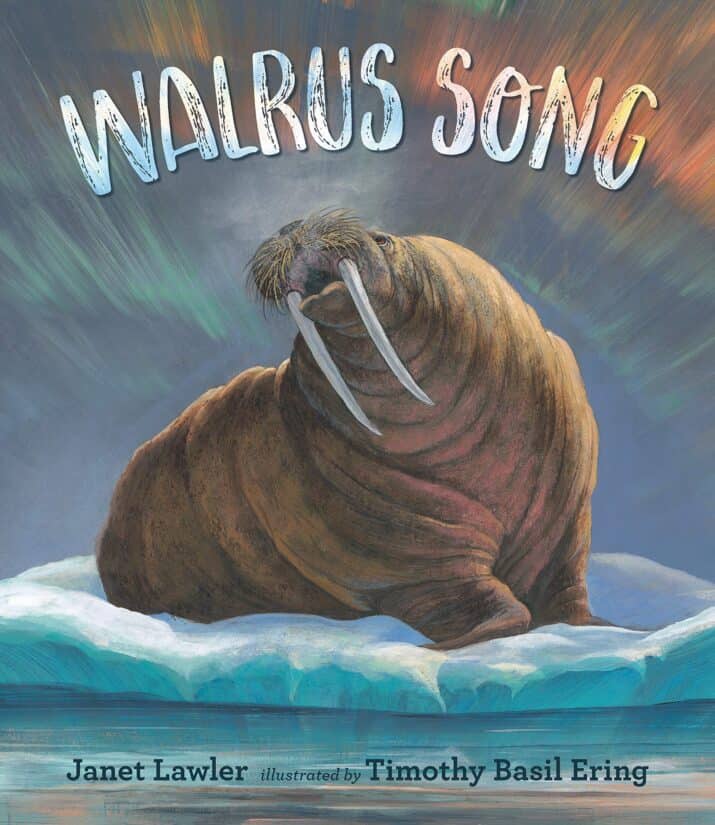
Walrus Song written by Janet Lawler, illustrated by Timothy Basil Ering
Lyrical writing and powerful verbs, this is a beautifully written book with dramatic illustrations and minimal text about the life of a walrus underwater, above water, fighting, making sounds, and more. “Waddle. Walk. Slap! Slap! Walrus lumbers. Flippers flap.” Back matter gives more facts about the life of a walrus. For example, for “Digging, wiggling…seafloor stewing“, it says, “Like a bristled brush, a walrus’s snout sweeps along the ocean floor. Its whiskers are sense organs that feel for clams and other foods.”

Volcanoes written by Nell Cross Beckerman, illustrated by Kalen Chock
The writing in this spectacularly illustrated book SINGS and INFORMS and DELIGHTS. Vivid verbs, figurative language, poetry, and exposition, this nonfiction gem is a must-own because it’s a masterpiece of writing. Use it to teach earth science as well as writing craft. In fact, you’ll be able to model for growing writers the crafts of word choice, figurative language, voice, fluency, research to exposition, and more. This book is an essential, wonderful addition to all classrooms, libraries, and homes.

Creep, Leap, Crunch! A Food Chain Story written by Jody Jensen Shaffer, illustrated by Christopher Silas Neal
The first half of this book is a cumulative food chain story that starts with the sun and the plants, then continues to the smallest prey, a cricket who eats grass. Each page adds on a predator who eats the prey— the mouse eats the cricket, the snake eats the mouse, all the way up to a brown bear eating the fox. Then, the story gives way to a bit of hope for gentle readers who might be disturbed by all this eating… because some days, the cricket hops away from the mouse, and the fox sneaks around the black bear, and none of the animals get eaten. Hooray! Back matter explains more about the forest and the animals. This is a perfect STEM read aloud introduction to food chains and forest biomes.
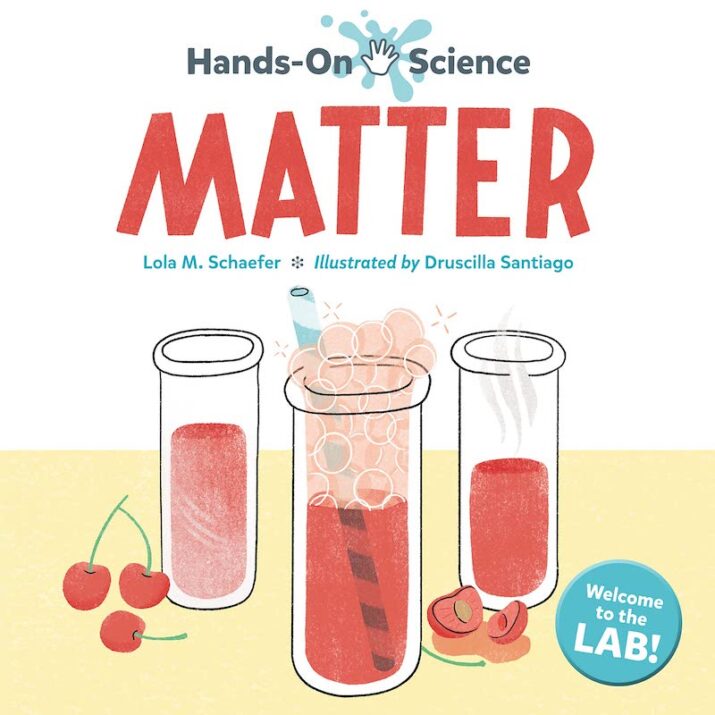
Matter (Hands-On Science) by Lola M. Schaefer, illustrated by Druscilla Santiago
This picture book is a fantastic introduction to chemistry with clear text and illustrations. Simple, interactive experiments show children hands-on examples of the states of matter from solid to gas to liquid that kids can do at home as they read and in real life. For example, “put” the sugar into juice and watch it dissolve. Next, place the juice in the freezer and close the door, aka. turn the page. While you wait, you can predict what will happen by tapping on the picture showing what you think might happen to the juice in the freezer. You’ll turn the page to see…it’s solid ice! Isn’t that brilliant and interactive!?

Stone Age Beasts written by Ben Lerwill, illustrated by Grahame Baker-Smith
Kids will love this interesting oversized book about the cool creatures from the Stone Age. Each two-page spread is filled with a mesmerizing illustration and accompanied by fascinating descriptions of the creature along with a sidebar of facts, including a world map of its location. For Siberian Unicorn, the author writes, “Unicorns in fairy tales are normally dainty and elegant, but this spectacular real-life beast was a gigantic mass of fur and muscle.” Read about the Wolly Mammoth, Elephant Bird, Wonambi, Saber-Toothed Cat, Cave Lion, Dire Wolf, and more! A new favorite!!

Dictionary of Dinosaurs edited by Dr. Matthew G. Baron, illustrated by Deiter Braun
Got a dinosaur-loving kid? I predict this illustrated encyclopedia of dinosaurs will be their new favorite book! Most dinosaurs are colorfully illustrated. Every dinosaur includes how to pronounce their name, information about their size, when it lived, where it lived, their diet, and more information. It’s FASCINATING. I also love the graphic-style illustrations.
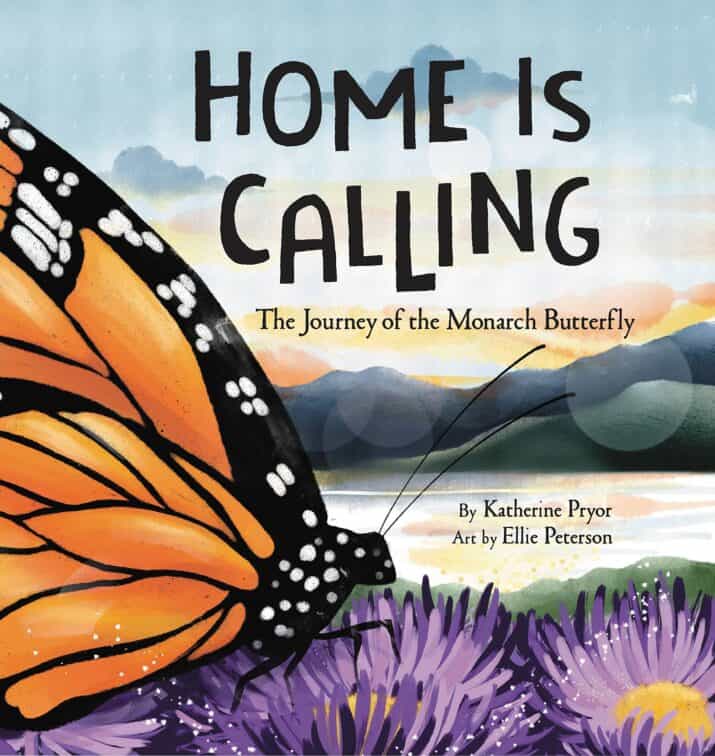
Home Is Calling The Journey of the Monarch Butterfly written by Katherine Pryor, illustrated by Ellie Peterson
This exceptional picture book shows the monarch butterflies’ long journey, traveling day after day to a new home, distant relatives, and safety. Written from the “we” point of view, the butterflies see sunsets and sunrises, sunsets and sunrises. They fly and fly, feast and drink, shelter and huddle, soar and ride the wind. After two months, they arrive, safe at last, to their new home with all the other orange and black butterflies!! The stunning illustrated pages are filled with monarchs in motion.

Except Antarctica! by Todd Sturgell
A stoic narrator begins by sharing information about turtles until…the turtle, who doesn’t live in Antarctica, sets off for Antarctica, making the narrator very irked. Soon, the turtle is joined by other animals also NOT found in Antarctica. Hilarity ensues with an increasingly exasperated narrator and bothered turtle who does not want any traveling companions which include a dung beetle, owl, snake, bee, mouse, and frog. Several pages of back matter explain more information about each animal and the continent of Antarctica.

Look What I Found in the Woods written by Moira Butterfield, illustrated by Jesus Verona
I love this picture book of informational text about the woods with interactive questions, engaging writing, and fantastic design. Learn about plants, trees, bark, leaves, nuts, pinecones, and bugs. You’ll appreciate that the last page reminds children to only collect things that they find on the ground.
 Libby Loves Science written by Kimberly Derting and Shelli R. Johannes, illustrated by Joelle Murray
Libby Loves Science written by Kimberly Derting and Shelli R. Johannes, illustrated by Joelle Murray
Libby loves science and experiments with recipes and experiments at school. Chemistry reminds her of cooking. At the science fair, she and her classmates need to attract more people to the booth to show that science is fun but their experiments don’t win them the prize of an ice cream party. Their teacher reminds them that it’s about trying, not winning.

Am I a Frog? by Lizzy Rockwell
Don’t miss this fantastic nonfiction easy reader! The simple text narrates a conversation between a tadpole and the author. The author answers the tadpole’s questions and explains to the tadpole about his characteristics now (gills like a fish, a tail that helps him swim) and the upcoming change into a grog (grow front legs, shorter tail, and jumping out of water).

Pizza: A Slice of History by Greg Pizzoli
Pizza fans, check out these tasty tidbits, history, and facts about your favorite food. Where did pizza originate? Greece or Persia? Or Naples, Italy when a man named Raffaele Esposito created a pizza with tomatoes. One or two sentences per page, this informative book hits the right spot for ages 4 to 8 year olds.

Animals in the Sky by Sara Gillingham
Riddles prompt kids to guess the animal in the constellations and then check to see if they’re right with lift-the-flap answers and more information. “I have a big bushy mane, a long tail, and a loud roar. I am the king of the jungle! What animal in the sky am I? I am the Lion. My brightest star is called Regulus, which means “little king.”” The white and gold text and illustrations pop out off the page.

What’s in Your Pocket? Collecting Nature’s Treasures written by Heather L. Montgomery, illustrated by Maribel Lechuga
A delightful introduction to both collecting and to famous scientists when they were curious children and their later contributions as adults. Gorgeous illustrations and clear text will captivate readers as they learn about kids like Diego who collected snails as a child and later became a herpetologist, Mary who collected caterpillars and eventually wrote a book on metamorphosis, or Bonnie who collected sea slugs and later helped discover a new kind of sea slug. Readers will be inspired to start their own collections and see where their curiosities take them!

Packs by Hannah Salyer
Beginning with minimal text, these gorgeous, captivating illustrations show groups of animals–herds, pods, packs– animals together. As you’re invited into the book, the author presents more interesting text written from the collective we like this, “We frogs can become one noisy army…Together, we sing!“

Willow The Therapy Dog (Doggy Defenders)
Willow works as a therapy dog to help people feel better if they are sad — like patients in the hospital and students at a school and retired veterans. And the photos of Willow in her pajamas after a long day of work are absolutely adorable.

Tiger The Police Dog (Doggy Defenders)
Tiger is a Belgian Malinois police dog. Tiger works with a police officer to protect the city. Tiger sniffs for danger in different places like a school or a metro trash can. Also read: Stella the Search Dog (Doggy Defenders).

Fly Guy Presents: Dinosaurs by Tedd Arnold
It’s such a genius idea of Tedd Arnold to create a nonfiction easy reader series with his popular characters! In Dinosaurs, Fly Guy and Buzz visit the museum and learn about dinosaurs. Kids will love the combination of comics and photographs as well as narrative and informational text. Each of the books in this series is about a field trip to learn about the book’s topic.

This Is My Brain! A Book on Neurodiversity written and illustrated by Elise Gravel
Colorful cartoon illustrations and kid-friendly language introduce readers to the brain, a squishy thing that has superpowers and controls everything the body does. Characters add their own dialogue to show how our brain learns, experiences senses, and feels. The book feels informative and playful instead of didactic. This book will make a great learning tool for parents and educators.

All the Birds in the World by David Opie
As the narrator talks about what makes birds birds, the kiwi bird asks “What about me?” on every page. Eventually, we’ll learn the answer to the little bird’s question…even though she doesn’t fly, has no tail and has a beak with nostrils, she is part of the bird family. It’s a wonderful, inclusive book with gorgeous illustrations of birds of all kinds. Valuable back matter gives readers a key to the names of the birds on each page.

Free For You and Me written by Christy Mihaly, illustrated by Manu Montoya
Rhyming basics tell readers all about the five protections in the 1st Amendment of our U.S. Constitution — free speech, free press, and more. Straightforward and well-written, this will be a helpful addition to elementary classroom learning about government.

Sun and Moon Together written by Ethan Long
Long’s created a community (Happy County) with silly cartoons and stories that explain factual information while engaging reader’s attention. Learn about the Sun and the Moon, the water cycle, the solar system, and delight in stories about characters like Wilbur and Orzo Bright whose hot air balloon pops and sinks to the bottom of the ocean. There’s so much to learn, see, and do in this entertaining book.

Caterpillar to Butterfly by Laura Marsh
Kids love the simple text matching each beautiful photograph. These books are bright, colorful, and informative — perfect for any beginning reader around ages 5 or 6.

Woodland Dreams written by Karen Jameson, illustrated by Marc Boutavant
A little girl and her dog walk through the woods, saying goodnight to each of the woodland creatures. Similar poetic text structure and soothing wordplay, “Antlered swimmer / Pond-weed skimmer / Daylight’s fleeting — wade ashore / Bed down in the great outdoors.” Rich, earthy illustrations give this book a warm, cozy feel.

Amazing Dogs DK Level 2 by Laura Buller
Not only is this nonfiction book relatable because of most kids interest in dogs, but it’s also fascinating. (I learned a few things myself.) Talk about a great high-interest nonfiction book for beginning readers! Added to FAVORITE DOG BOOKS FOR KIDS.
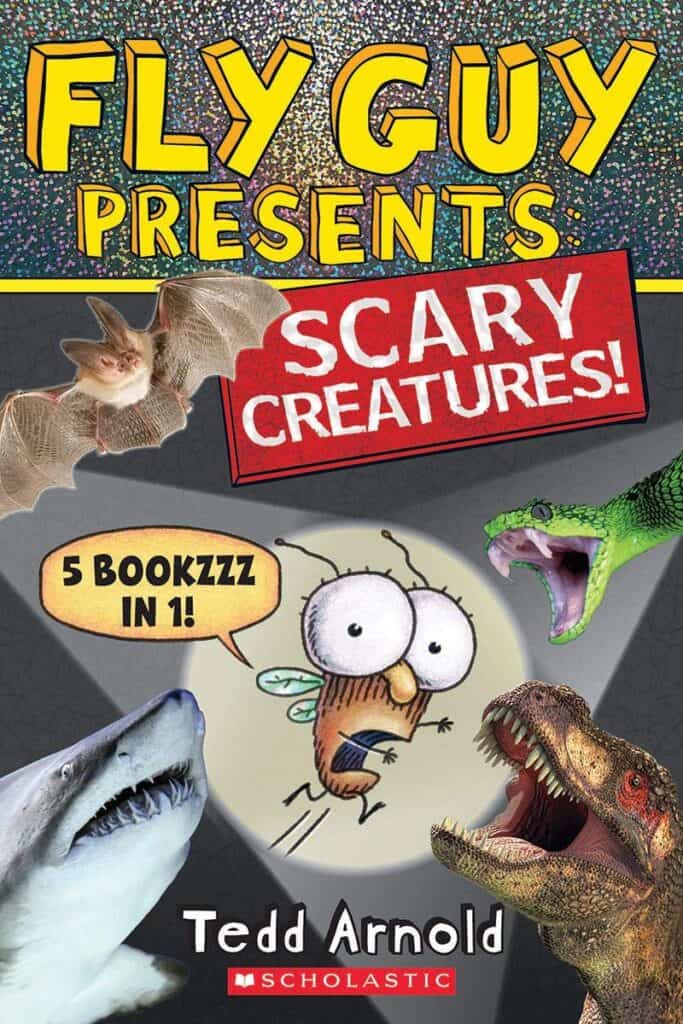
Fly Guy Presents Scary Creatures! by Tedd Arnold
Get 5 books in 1 in this large-sized book filled with these level 2 titles: Sharks, Dinosaurs, Insects, Bats, and Snakes. Fly Guy and Buzz visit places like the aquarium or the museum to learn about different creatures. Colorful drawings and photographs illustrate the topics about which they’re learning with an appealing layout. The text of facts and conversation bubbles are just-right and comprehensible for growing readers.

The Brain Is Kind of a Big Deal by Nick Seluk
Kids will learn so much about the brain in this well-done, humor-filled book with pacing and flow that will hold readers’ attention. Plus, they’ll love the cartoon panel illustrations and the text to picture ratio.

Smithsonian Early Adventurers Level 1 Readers: Safari Animals, Animal Habitats, Insects, Vehicles, Outer Space, Reptiles written by Brenda Scott-Royce, Ruth Starter, Emily Rose Oachs, and Kaitlyn DiPerna
Get this early reader book right away for any child who loves nonfiction and animal facts. They will enjoy learning all the cool information. Great photos, good text to photo ratio, and excellent use of predictable, repetitive text.

My First Book of Hockey Sports Illustrated Kids A Rookie Book
I highly recommend this informative nonfiction book for ages 5 and 6. Cool graphics, simple text, and full-color color photographs teach young children about the game of hockey.

Over and Under the Rainforest written by Kate Messner, illustrated by Christopher Silas Neal
A child narrates what he experiences during a rainforest hike. The child notices the wildlife living up in the canopy and down below on the ground–animals like capuchin monkeys, leaf-cutter ants, sloths, and parrot snakes. Descriptive imagery plus beautiful illustrations transport readers to this verdant ecosystem. “High in the canopy, a furry dark shadow clings to a branch.“

I am Martin Luther King, Jr. (Ordinary People Change the World) by Brad Meltzer, illustrated by Christopher Eliopoulos
This nonfiction book series is a great choice for growing readers. The text to picture ratio is perfect and the narrative is interesting.
MORE Ordinary People Change the World Recommendations:
I am Albert Einstein
I am Helen Keller
I am Rosa Parks
I am Jackie Robinson

Egg to Bee LifeCycles by Camilla de la Bedoyere
Large pages, colorful photographs, oversized print, bolded vocabulary words, and interesting information make this a good addition to any elementary classroom. You’ll learn about the bees, hives, laying eggs, growing and eating, queen, and more. This is just one in the new easy nonfiction picture books in the LifeCycles series. Other titles include Tadpole to Frog, Seed to Sunflower, Caterpillar to Butterfly, and Egg to Chicken.

Highlights Hidden Pictures Sticker Book
Younger learners can the stickers to find hidden objects. So fun! My kids always preferred the sticker hidden picture books to the color books.
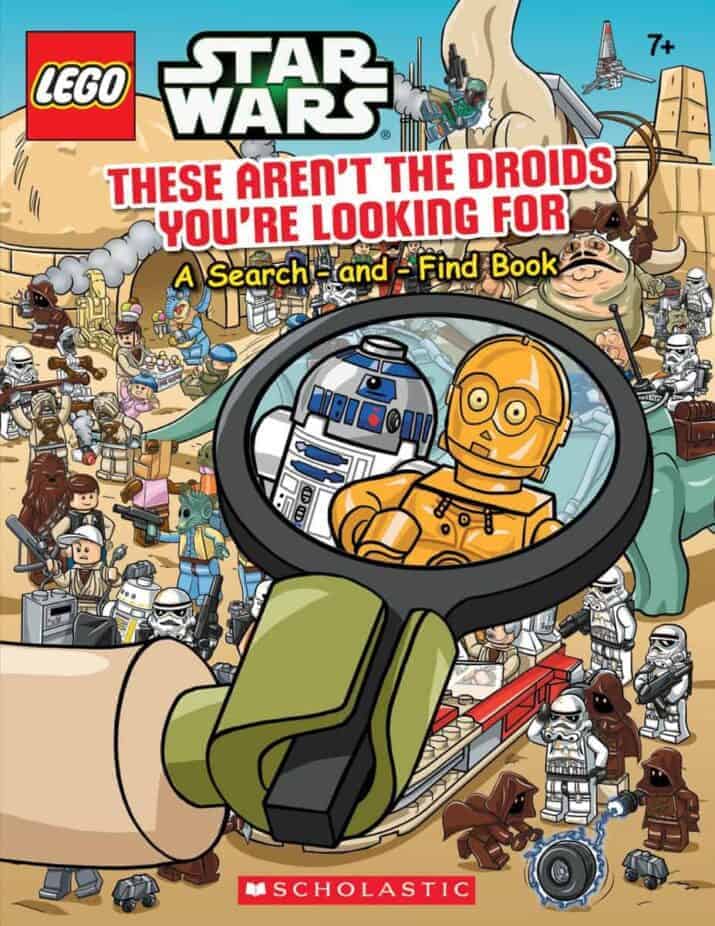
LEGO Star Wars: These Aren’t the Droids You’re Looking For by Ameet Studio
If your kids like LEGO and Star Wars, they’ll love this activity book!

45 Games While You Wait by Auzou
Use the provided dry erase marker to do these adorable puzzles for early learners. The book is organized into three sections: observation, puzzles, and mazes. In the observation section, you might find the difference in ogre shadows or find the differences between the two illustrations of Professor Neutron. In the puzzle section, you’ll find word searches, sudoku, and more. The mazes section is pretty self-explanatory but all with fun themes like Treasure Island or Sherlock Holmes.

Dogs by Emma Helbrough
My kids and I love this early reader series — the format and information in all the Usborne Beginning Reader books are excellent.

What Do They Do With All That Poo? written by Jane Kurtz, illustrated by Allison Black
Learn about the poop of different zoo animals — pandas, hippos, elephants, hyenas, bats, and more. You’ll read what’s in each animal’s poo, the shape and color, and other pertinent facts. “Each rhino’s poop has its own unique smell. Rhinos smell dung to gather information about one another.” Then, the book answers the title’s question –what does the zoo do with so much poop? Well, they put it in trucks and dump it into landfills, send some to scientists, or make compost. Among other things. If you’ve ever been curious about animal poop, quell your curiosity with this informative picture book.

Orangutan Houdini written by Laurel Neme illustrated by Kathie Kelleher
What an interesting picture book story based on a real life story! Fu Manchu, the orangutan, keeps escaping from his enclosure in the zoo. He doesn’t leave the zoo, just hangs out in the trees and always returns when his keeper comes to get him. Fu is one clever orangutan! Written like a story in narrative format, this is an excellent nonfiction picture book.

Goodnight Hockey (Sports Illustrated Kids) written by Michael Dahl, illustrated by Christina Forshay
At the city’s outdoor arena, the hockey action is fast-paced and easy to follow through the book’s narration and illustrations. And when it’s game over, the kids happily say good-night. I’m impressed at how well Goodnight Hockey introduces young children to the game basics.

Show Me Dogs My First Picture Encyclopedia by Megan Cooley Peterson
Do your 5- and 6-year-olds love animals? This book will entice your kids to devour facts all about the animal they love — dogs!
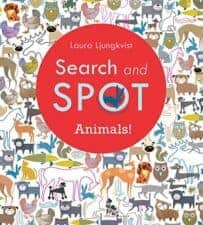
Search and Spot Animals! by Laura Ljungkvist
I’m SO in love with this nonfiction picture book! Instead of an overwhelming mashup of illustrations, Ljungkvist’s illustrations are simple, clean, and not too crowded. For example, on a bright yellow background, look at the purple and blue chickens to find a dozen eggs. Or, on a blue background, search and spot 10 dragonflies sitting on blue lily pads next to green frogs. Lovely.

You Are a Raccoon! written by Laurie Ann Thompson, illustrated by Jay Fleck
Written in the second person point of view, you are a raccoon. As you read, you’ll learn about your family and den and sounds. Read about getting bigger, finding food, and waking at night with other nocturnal animals. Playful verbs invite you to act out raccoon actions. A must read for preschoolers; it’s informative, interactive, and fun.

Animals in Pants written by Suzy Levinson, illustrated by Kristen & Kevin Howdeshell
These funny poems will delight readers with their rhyming and silliness. Manatees in dungarees, kangaroos in jumpsuits, giraffes in kilts, and spiders who put on their pants one leg, one leg, one leg, times eight at a time.

Mad Libs Junior Animals
Invent super silly stories with your friends and family. No need to remember parts of speech because the junior book uses pictures instead so even 5 and 6-year-olds can write these fun stories.

Hippos Are Huge! written by Jonathan London, illustrated by Matthew Trueman
Excellent writing and illustrations make this one of the best nonfiction animal books because you don’t realize you’re learning so much about hippos because it’s so interesting and well laid out! Bigger text pairs with smaller factual text to give readers maximum learning. Hippos are COOL and DANGEROUS — you’ll find out when you read this book.

Winnie The True Story of the Bear Who Inspired Winnie-the-Pooh written by Sally M. Walker, illustrated by Jonathan D. Voss
Did you know that Winnie the bear was a real bear? Canadian vet and WWI soldier, Harry Colebourn, rescued a bear who he named Winnipeg and took her with him to training in England. But when he was sent to battle, Harry sent her to the London Zoo so she would be safe from battle. That’s where Christopher Robin and his father, A. A. Milne, met Winnie. You’ll love the photographs of the real Winnie!

Feathers: Not Just for Flying written by Melissa Stewart, illustrated by Sarah S. Brannen
I think this nonfiction picture book actually has the perfect ratio of words to text! It’s informative without being an epic essay and the warm water-color illustrations are gorgeous. Readers learn that feathers can shade, warm, protect like sunscreen, make high-pitched sounds. Plus, they will discover examples of birds in the wild with each feather fact. Honestly, I never appreciated feathers before this book. It’s so well-presented, it should be included in all classroom studies on birds.

I, Fly The Buzz About Flies and How Awesome They Are writtenby Bridget Heos, illustrated by Jennifer Plecas
I liked this picture book with comic dialogue about the oft-neglected fly. You see, kids always study butterflies and rarely know that flies metamorphose, too — and Fly wants to convince you that you should really know more about him! Flies are so interesting — they make noise (butterflies don’t) and they have big families (500 maggots) and help solve crimes (age of maggots on a dead body . . . ) just to name a few things.









